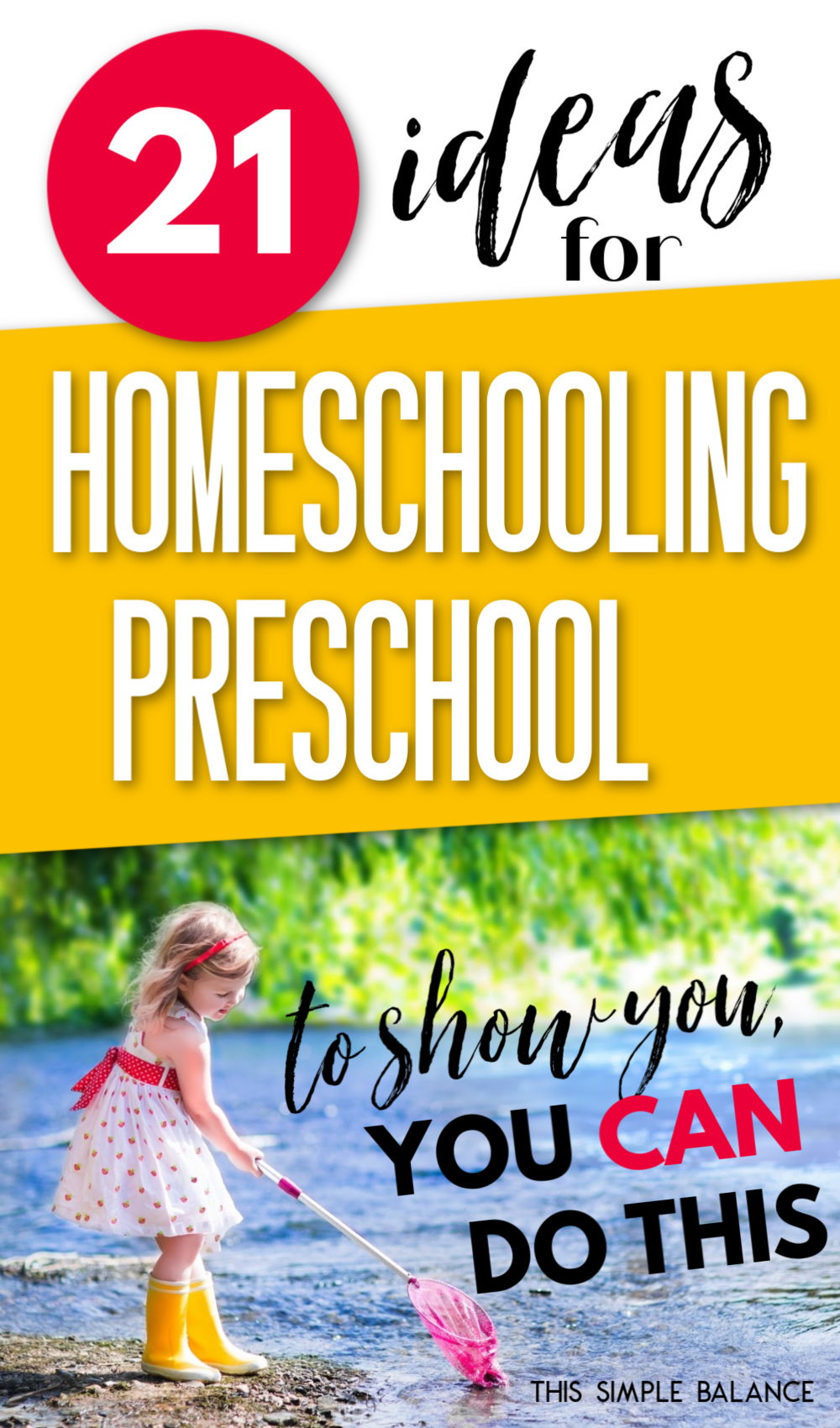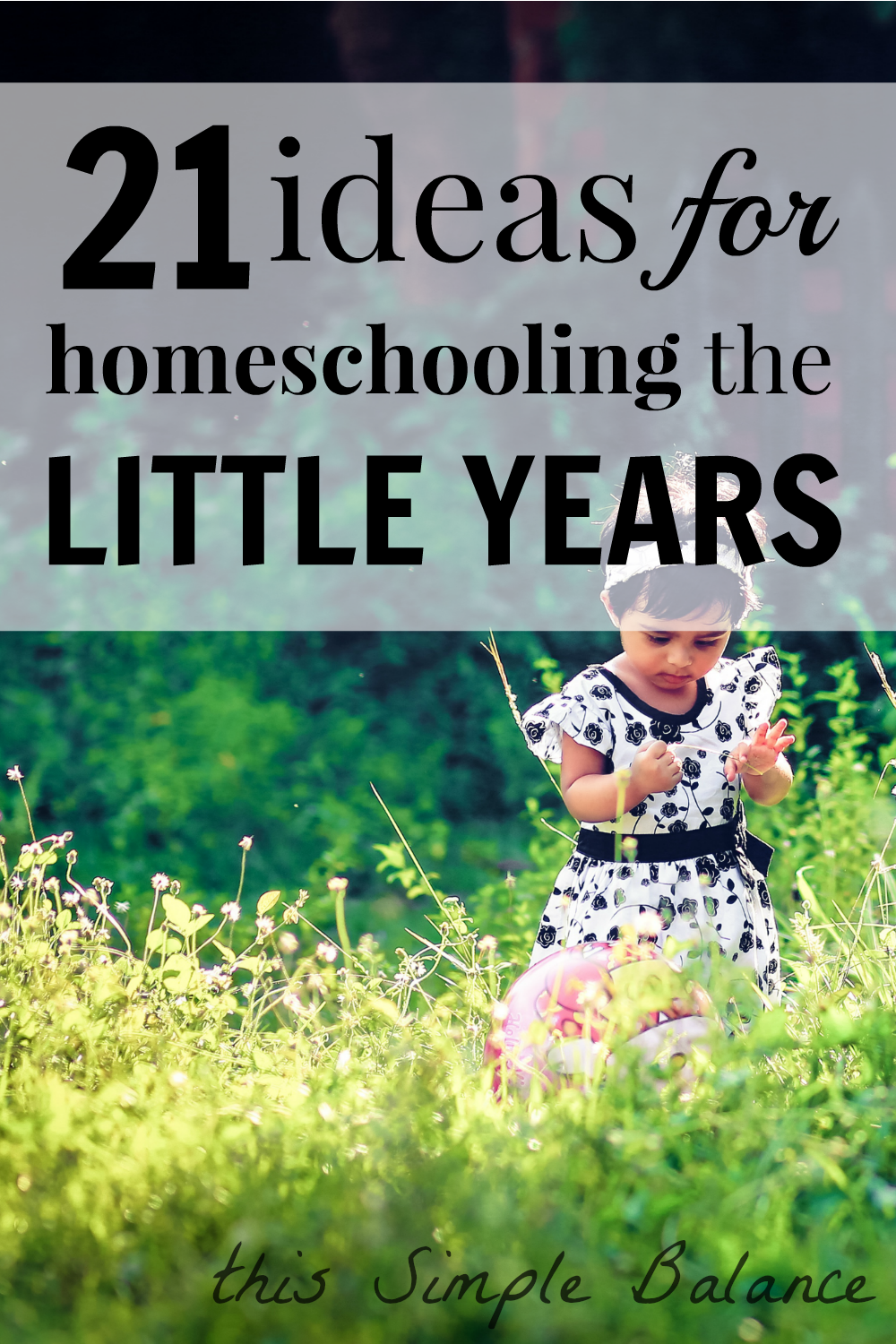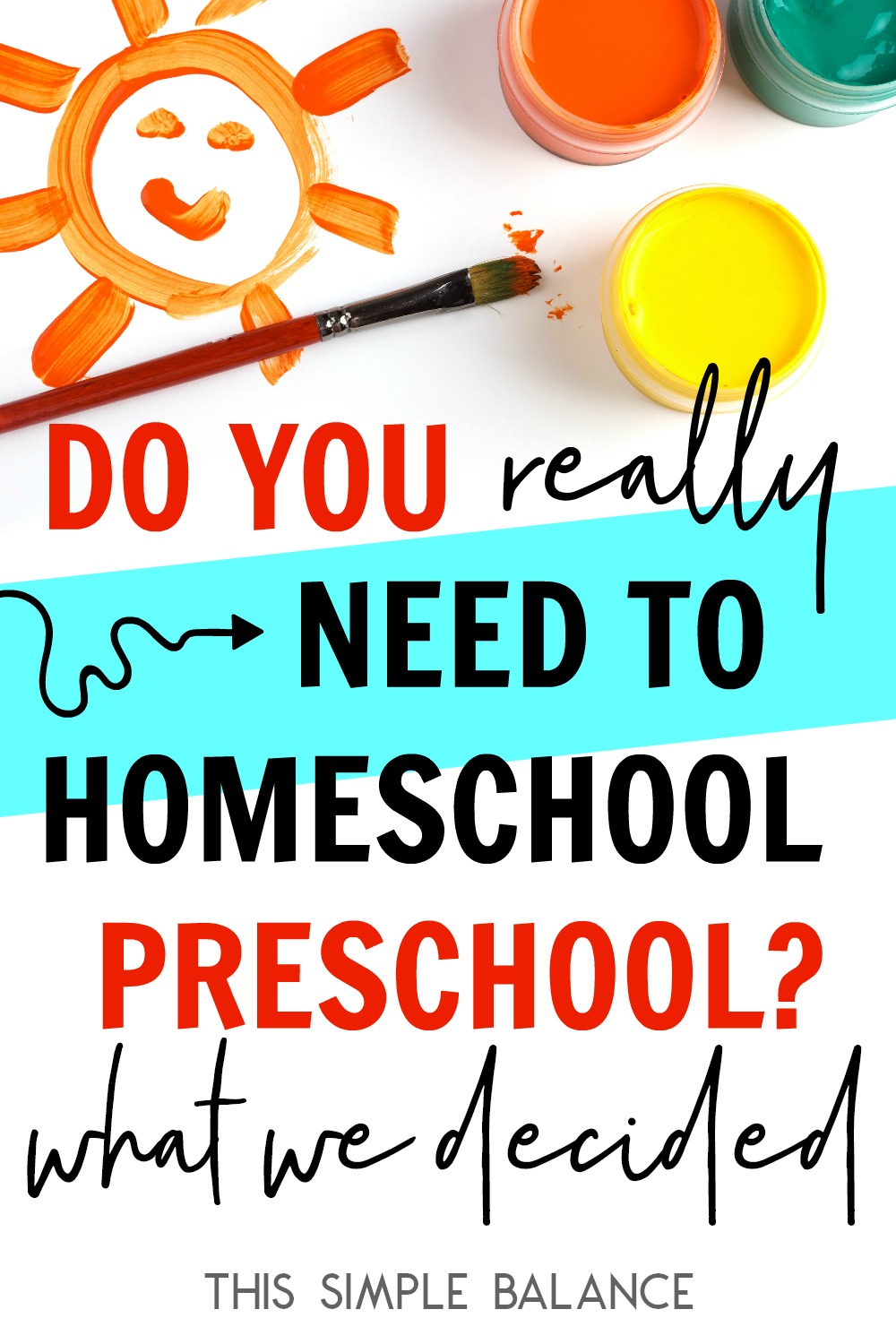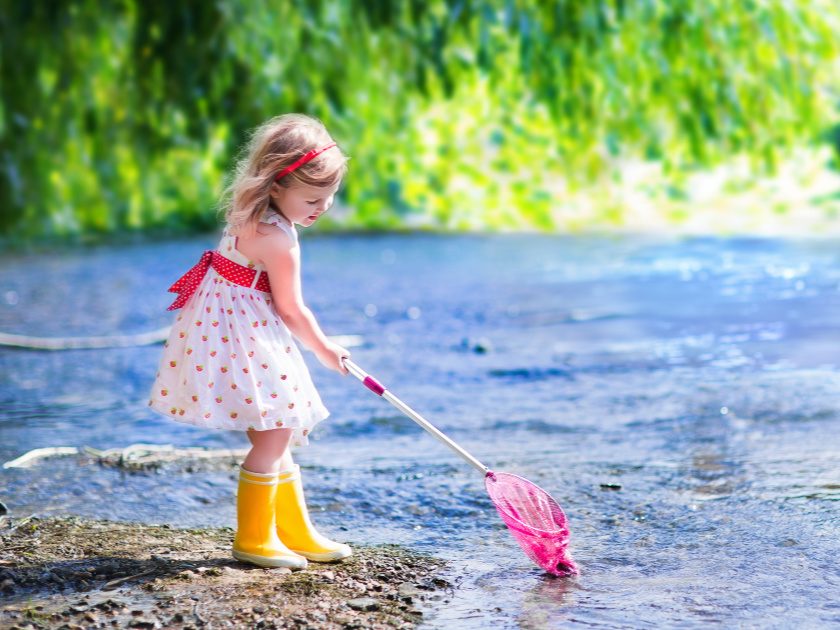Inside: Are you stressed figuring out how to homeschool preschool? You really don’t need to stress about preschool. There are about a million everyday life things that “count” as school! Here are 21 ideas to help you realize that life IS school.
Like many others who start homeschooling who have no prior experience, I once thought of school as just workbooks and textbooks and sitting at a desk (kitchen table) for hours.
I way overcomplicated homeschooling preschool.
The “school-at-home” style of homeschooling just didn’t work for us.
I hated it, and my daughter hated it (the only one in formal “school”). I especially hated the constant interruptions from the younger ones all day long.
In order to make homeschooling work with this many little kids in this season of life, I had to redefine what “learning” looked like.
Now, instead of feeling guilty for not having hundreds of completed workbook pages to make our homeschool look more legitimate, I’ve realized that all the things we do now are not only valid forms of learning, they are arguably superior to what a classroom can offer my preschooler.
These things actually allow my kids to surpass their grade level learning and be in “school” every single day. If you want to homeschool preschool, you need to figure out how to make homeschooling a lifestyle.
Kids are wired to learn, to love learning in fact, if we only get out of their way and let them.

21 Ideas for Homeschooling Preschool
THIS POST PROBABLY CONTAINS AFFILIATE LINKS. AS AN AMAZON ASSOCIATE, I EARN FROM QUALIFYING PURCHASES. YOU CAN READ OUR FULL DISCLOSURE POLICY HERE.
1. Answer their questions.
Sound simple? It is. But how many times have you brushed off a question…in a few minutes, after I do X,Y,&Z. By the time you get to it, they’ve already moved onto something else.
Seize their curiosity! Stop what you’re doing immediately and find the answer. It’s at your fingertips: pull out your phone and google it. Grab a book off the shelf. You will accomplish so much just by answering their questions.
Kids are born with overflowing curiosity. It’s only lack of answers and not knowing how to find the answers that snuffs it out.
2. Math facts in reverse.
My three year old came up with this idea. One day, while driving in the car, he started quizzing me! “Three plus three is?” “Six!” I responded. “Yep!” was his confident reply (as though he knew the answer all along).
As I played along, he continued to give me more complicated problems. I am 100% certain he is filing away my responses in that smart little brain of his.
3. Display maps in your home.
Ours is positioned right above our kitchen table. The kids spend a ton of time there, eating and drawing and crafting.
They point out countries they know. I correct as needed. They ask about countries that are their favorite colors. They ask why there are two Pacific Oceans (the world is round).
Guess what? That’s geography!
Read More: 14 Simple & Fun Ways for Kids to Learn Geography
4. Buy and do puzzles together.
Speaking of geography, puzzles are a way to learn using multiple senses. We have this wonderful, wooden Melissa & Doug United States puzzle (my three year old can do it now!).
My parents also gifted us an Africa puzzle. The kids do these puzzles over and over. They know many of the countries and states by heart and have a basic grasp of geography I never learned in school.
5. Play games in the car.
On a recent trip, we played the license plate game. If you’ve never played, you simply try to see all fifty states’ license plates marked off your list.
What did we learn? How to alphabetize state names, state abbreviations, subtraction to find out how many we still needed to find.
Even seemingly innocent games like Guess the Animal teach things like animal names, animal features, animal families, logic, geography, reasoning, and how to ask good questions.
6. Divvying up food between siblings.
When we get fast food nuggets, we order an entree and divvy them up. I bought a 20 piece nugget and divided the nuggets between my three older children.
My daughter asked, “Mom, how did you know we would each get 6?”
A long-division lesson commenced, complete with remainders (there were two, which I promptly ate).

7. Read-aloud, read-aloud, read-aloud.
For any subject you want to teach, there is a good picture book to go with it. Besides teaching academic subjects, kids learn so much from books: character, conflict resolution, empathy and emotional awareness.
Guess what? Public schools dedicate classroom time to these subjects with a curriculum. Quality literature can teach it much better.
Related: 70 Picture Book Biographies for Kids (with free printable list)
8. Talk about money in everyday life.
While driving home from the grocery store one day, my son asked if we could go to Chick-fil-a the next day. I told him we were going to skip it this week because we spent $35 eating out two days before.
We only have $100 in our eating out budget, and as it was early in the month, we needed to save some for the latter half of the month. My daughter did some mental math to figure out how much we had left in our budget that month.
That definitely counts as homeschooling preschool.
Related: How to Homeschool Math Without a Curriculum
9. Make time for rich, spontaneous conversations.
At the beach, we were digging in the sand, joking about digging to China. I mentioned to the kids, “Did you know that people used to think the world was flat?” “Really?” they responded curiously.
We told them to look at the horizon and compared it to a beach ball. “When you look at the ball straight on, can you see the other side past a certain point?”
“No.”
“That’s why people believed the world was flat, and the first man to say otherwise was almost killed for saying it was round! People thought he was crazy!”
“Woah,” their jaws dropped.
History lesson at the beach.
10. Bake and cook together.
So many lessons here:
- reading letters and numbers
- the importance of following directions
- why certain ingredients change the dish the way they do (science)
- fractions
The list could go on and on. It might take you longer (and be messier) to involve your preschool age child in baking and cooking, but it definitely counts as homeschool.
Read More: 8 Easy Ways to Unschool Science – for Fun, Natural Learning
11. Spell words for your child.
When my kids were younger, this question used to drive me crazy! I couldn’t wait to introduce some kind of formal spelling curriculum so that they had a systematic way to learn spelling. But the more my daughter read and the more she wrote, the more her spelling improved. She guesses correctly more often than not now.
Her younger brother (creator of “Reverse Math Facts” above) now asks “How do you spell?” And it all begins again. We never did get to that formal curriculum, and my daughter can spell on or possibly above grade level.
12. Build with LEGOs.
Building with LEGO develops fine motor skills, teaches creativity and problem-solving.
Playing with LEGOs prepares kids for engineering careers by teaching them to think three-dimensionally.
13. Go for hikes and nature walks.
When you take your kids on hikes and nature walks, all it takes for learning to happen is you modeling curiosity. It comes naturally to some, and takes intentionality for others.
Notice bird calls. Show them nests. Point out interesting bugs and plants. Whatever peaks your interest, talk about that.
Parental enthusiasm is contagious and is essential to successfully homeschool preschool.
14. Do something YOU love (and let your kids watch).
Julie Bogart of Brave Writer (a writing curriculum) called it “awesome adulting”. It is vital that you have something you love that your kids see you doing. Your passion will inspire them.
When I started blogging, my daughter immediately asked to start writing stories of her own. Another friend I know started selling makeup on the side, and her daughter immediately caught her enthusiasm.
Part of the beauty of homeschool is letting your kids see you in real life, whatever your real life looks like.
15. Involve them in cleaning and laundry.
It’s called lifeskills. And how many friends did you have in college who didn’t know how to do these things?
Many high schools offer a lifeskills class and require it. This is absolutely “school”.
Have them match socks, give them a spray bottle filled with water to work alongside you as you clean the kitchen floor, or let them vacuum using the crevice attachment (my preschooler LOVES to do this!). Give them something age-appropriate, but meaningful to do to help.
16. Have them sit with you while you pay the bills.
More life skills. Math, how to write a check, budgeting.
These skills are essential to success in life, yet so few people really know how to manage money.
Talk out loud while you do math in your head. Give them a pencil and paper to write numbers while you work. Talk them through what the bills pay for: electricity, groceries, your home.
Give them an idea where your hard-earned money goes every month.
17. Watch educational shows.
If I had a dollar for every fact my son tells me about animals after watching Wild Kratts, I’d be rich!
Media is a tool. We need to learn how to use it without freaking out (I’m still getting there).
Wild Kratts, Super Why, Word World and the Magic School Bus are some of our favorite ways to learn reading, math and science. In order to watch all the seasons of PBS kids shows without cable, we subscribe to the PBS kids channel on Amazon Prime.
This one again requires a bit of intentionality. Errands can look like kid bored and frustrated slumped in the back seat OR it can look like kid engaged in the process, asking questions, getting input, and loving learning how to do an “adult” thing.
The grocery store, the bank, the thrift store – all excellent learning opportunities. Real life.
19. Write cards & letters.
I don’t know who doesn’t like to receive an actual note in the mail as opposed to junk mail and bills.
Most people don’t have time to send hand-written letters. Homeschoolers do.
Kids love to learn in meaningful ways. They could learn writing by copying letters again and again on a handwriting worksheet, or by writing a card that will brighten someone’s day.
Which would you choose?
Related: Unschooling Language Arts – A Guide for the Elementary Years
20. Make time for LOTS of pretend play.
Kindergarten used to be letter recognition, social skills, and a whole lot of play. Now kindergarten is what first grade was thirty years ago (which is why I chose to homeschool kindergarten).
And the academics are quickly taking over preschool, too. Yet another good reason to homeschool preschool.
Kids learn SO much through play. But it’s not just fun; it’s vital to their emotional and physical health and development.
They learn how to interact with people, social norms and behaviors. They process information and emotions and experiences through pretend play as well.
Play is vital to the social, emotional, and intellectual development of our children, and they get far too little of it.
Let the children play!
21. Take weekly trips to the zoo, museum, or aquarium.
Learning about animals on T.V. or through books is o.k. Learning about them in the real world is better.
If at all possible, make “field trips” a weekly occurrence while homeschooling preschool.

Change Your Perspective on Homeschooling Preschool
Did this list help you see how homeschooling can be a lifestyle? It’s really not that hard to homeschool preschool.
You don’t need fancy curriculum or anything other than a library card and one more thing: YOU.
At the heart of a successful homeschool is a relationship with the adult that cares about your child more than anyone in the entire world.
Ultimately, no teacher on earth will care more about your child’s success and development than you will. And no teacher can give them the dedicated time and attention you can.
Your child learned to talk and walk just by being with you; they can learn to read, write, and do math the same way.
Homeschooling is a lifestyle, one where learning doesn’t fit into a neat 8 a.m. – 2 p.m. box. Comparing homeschooling to traditional school is like comparing apples to oranges.
If you want to homeschool preschool, you need to learn a whole new way of thinking about education. It takes a lot of time, but you can learn how to do it.


Don’t forget educational place mats! My kids didn’t fear the ‘periodic table’ when they got to high school, because they had been eating off of it for years! That’s how they learned the names of the states, countries, types of rocks, parts of a flower, dinosaurs, musical instruments and even the presidents of the United States. The math ones never helped anyone with anything though!LOL!
Thanks Julie! That’s a great idea – I’ll have to keep my eye out for one. 🙂
Hello, I love your blog! I am currently starting homeschooling/unschooling with my kids. I understand mostly what to do every day, I’m just having trouble getting my 7 yo to do anything. If I have an activity I’d think she would like or a show to watch, etc., she will say “nah” and go watch youtube on tv or her ipad. I don’t want to take away her freedom, but how can I encourage her to try something different? How can she learn different things about the world if she doesn’t want to do anything but watch youtube all day? You seem to cover a lot of different subjects every day. How to your kids get and stay interested? Thank you.
Hi Amy! Thanks for stopping by. A couple of thoughts come to mind. First, was your daughter in school before you started homeschooling? If so, you may need to read some articles on deschooling – Pinterest or Google will yield some great articles. Traditional school and homeschooling are very different, and you may need some time to adjust.
If she was never in traditional school, then you’ll need to think through it differently. While our kids probably watch more tv than most, we do have some limits as opposed to more radical unschooling families (which is why I like the term relaxed homeschooling better). During the week, they watch one educational show in the mornings (we rotate through our favorites) and are allowed to do educational games/apps on the ipad. Around 4:30 or 5:00 pm, they can watch what they like.
We do cover a lot in a day, but it’s all pretty informal. I love squeezing every drop out of natural life experiences. My recommendation would be to step back and observe for a while. Leap on any questions she asks – stop whatever you are doing and make it highest priority to find the answer (Google is my friend). You could also try audiobooks – my daughter loves them, and just listening to books does so much! It builds language skills and vocabulary, empathy, etc.
My daughter started out in a co-op three years ago (two days a week with a teacher and three days with me). Her first year home, she was pretty resistant to any formal academics and seemed to not want to do much of anything except read. When I backed off, her natural curiosity kicked in, and she really started to flourish, asking tons of questions, doing math for fun, etc. But that took time. It also took a while for me to learn to take advantage of natural learning moments during the day. I hope this helps!
This is wonderful! They really are learning all the time. My kids are also big Wild Kratts fans and they learn so much from those and other educational shows. I know you’ve mentioned media before, but I would love to hear about how you balance the media issue for your family. Do you allow certain shows at certain times, or have an overall time limit you try to stick to? What about computer/tablet games or research?
I’ve gone back and forth on media, especially because their interests and desires are constantly changing!
Ah, the media debate. To be honest, I’m still mulling over this one because it is so complex- I’m sure there will be a post when I come to hard and fast conclusions. Currently, the kids each watch an educational show choice in the mornings (roughly an hour of media). They are allowed to play educational games at any point during the day. Around 5 or so, they each have a show choice of their own (another hour). Sometimes, when dad comes home, they play some games on Apple TV apps. Weekends are far more loose and they watch more than I’d like most of the time. With four kids, homeschooling, living in suburbia, and both my husband and I introverts, I think it’s the best we can do in this season. Every kid is also different – I have one who will hop on a device any time I let her, and another who purposefully chose to play outside with a friend instead of watch with his siblings. So personality plays a big role, as well. When I have it sorted out and am completely comfortable and confident with our stance, I’ll share it!
This list is great! And definitely got me excited about the idea of homeschooling. I have mixed feelings about it mostly because I am concerned about furthering the Christian bubble problem, which I myself definitely experience now, but did not when I was attending public schools. I’d be interested in hearing your approach to preventing that problem!
Robin – thanks for your thoughts and question! So I think it depends on how you view a Christian bubble and what your perspective is on early childhood development. First, you need to know why you’re worried about the “Christian bubble” in the first place – that they won’t know how to interact with unbelievers? That they won’t have opportunity to tell people about Jesus? That they’ll be weird unsocialized homeschoolers? 😉 My personal stance on this is that I believe early childhood (11-13 and under, depending on maturity level) to be a formative time in my kids’ emotional and spiritual development. Our decision to keep my kids out of public schools has less to do with exposure to certain things non-Christian (although I really don’t want my kid learning the F word in kindergarten or hearing about sex from a distorted view at that age – and yes, it does happen in kindergarten now depending on what school your child attends), and more to do with my belief that it takes lots of time spent together with multiple opportunities for natural conversations about faith, how we view the world, and how we live life and make decisions in order to grow kids with a strong faith that they’ll want to share with others now and in the future. It takes much more time than putting them in traditional school allows. We are constantly outside that bubble now – running errands and playing with other kids at parks and play places. They have a chance to see the world, and we have opportunity to talk about how other people make decisions. Gradually, as they grow, we will give them more opportunities outside the “bubble” in order to learn, but I believe they need a bubble in order to grow strong in their faith and stay true to it once they are in the world full-time. I think you need to have a plan for eventually getting them outside the bubble. There are also lots of secular homeschool groups these days, so you could also choose to be a part of one of those if it’s still a concern. Hope that helps!